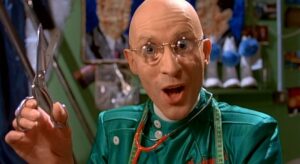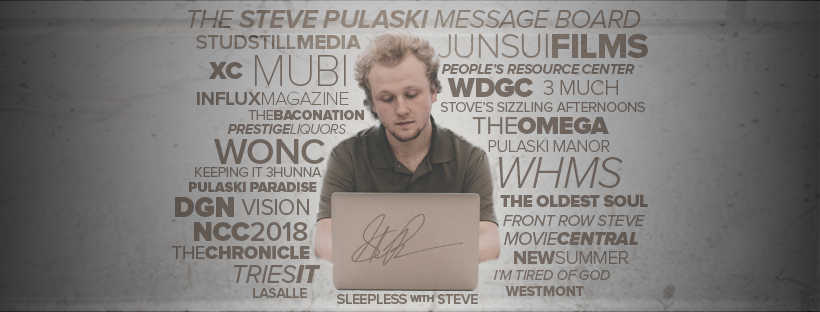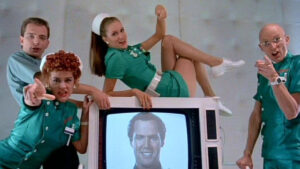Publication Date: 10-28-2025
Shock Treatment (1981) review
Dir. Jim Sharman
By: Steve Pulaski
Rating: ★★
Following paltry box office returns and scathing reviews, The Rocky Horror Picture Show might’ve been destined to a life of obscurity if it weren’t for a Fox executive named Tim Deegan. Tasked with the impossible challenge of marketing the film, he saw its potential as a midnight movie ala Pink Flamingos and Reefer Madness, first in New York City in April 1976, and then in other major metros across the country. A cult phenomenon was birthed, and Rocky Horror, as Deegan’s recently released book put it, went from an “orphan” to an “icon.”
Any creative person fortunate enough to witness their work finding success and adulation — especially after it appeared to be a lost cause — will understandably try and give the audience more of what they want. Richard O’Brien conceptualized a Rocky Horror sequel as early as 1978, with proposed storylines such as Rocky being resurrected, Brad ditching Janet for a romantic rendezvous with Dr. Scott, and Janet carrying Dr. Frank-N-Furter’s love-child. But when Tim Curry said he was perfectly content on keeping the wig and the corset in his closet, O’Brien had to go a different direction.

What we got was Shock Treatment, dubbed not a prequel nor a sequel but “an equal” according to O’Brien, who broke one of Notorious B.I.G.’s “Ten Crack Commandments” (Commandment #4: “never get high on your own supply”) before it was even put to music. When writer/actor Richard O’Brien, director Jim Sharman (who returns here), and the colorful, vibrant cast of The Rocky Horror Picture Show got together, they weren’t trying to make a cult movie. They were trying to adapt the popular stage musical and remain true to the songs, dance numbers, and themes of acceptance.
With Shock Treatment, they’re trying to appeal to the very base they had no idea they were trying to court, and in the mind of cultists who believe they’ve discovered a hidden gem that squares couldn’t pay to understand, that’s a death sentence — one that remains in place to this day, to the point where Sharman and O’Brien’s spiritual sequel is mostly dismissed even by the most ardent Rocky Horror fans to this very day.
Set in Denton, USA, the film catches us up with Brad and Janet Majors (now played by Cliff De Young and Jessica Harper), who are married and, for reasons never concretized, live in a town that’s one big television studio. What separates the mouth-breathing, dancing and singing audience from the participants in a great deal of low-rent, public access shows? That’s never made clear either. When Brad and Janet are selected to be part of a game show called “Marriage Maze,” hosted by by Bert Schnick (Barry Humphries), Brad is deemed mentally ill and committed to Dentonvale, a soap opera-esque show hosted by sibling doctors Cosmo (O’Brien) and Nation McKinley (Patricia Quinn). Janet gets the eye of Farley Flavors (also De Young), a fast food magnate who sponsors the Denton Network and hosts a show called “Faith Factory.” He wants to turn Janet into a star, and if you know one thing about this slut, it’s that she has no problem acting like a diva.

All this unfolds while two scorned television stars (Charles Gray, who still hasn’t grown a neck, and Ruby Wax) salty over their cancelled series, launch their own investigation into Flavors and the network entirely. They uncover some Earth-shattering revelations about Cosmo and Nation, which might’ve appealed to we, the viewers, if we were given enough of a reason to care.
The biggest problem with Shock Treatment is that there is no soft introduction to this world. Having seen The Rocky Horror Picture Show close to two-dozen times at this point, including five times within the last month, I’ve come to understand one of its key appeals the way it gingerly introduces the audience to the world of Transsexual Transylvanians. Brad and Janet serve as our conduits; dainty, conservative squares who are thrust into a world of sexual depravity they resist until their efforts ultimately prove futile.
Harper — who was in the middle of a meteoric run, with Phantom of the Paradise, Woody Allen’s Love and Death, and Suspiria under her belt prior — valiantly plays Janet not only in personality but in persona, hitting the high notes and owning her strut, with the movie lagging a couple paces behind. While it might not be fair to draw comparison, De Young’s Farley Flavors is no Dr. Frank-N-Furter, let alone a compelling antagonist. He’s all facial expressions and no magnetism that encourages you to take his bait.

With Shock Treatment, we’re not afforded the same sort of easy-launch. Things happen because Sharman and O’Brien’s screenplay insists they do, and the town of Denton, USA is a TV studio because of course it is. Brad’s disintegration into mental illness paired with Janet’s ascension to television diva means nothing because they don’t even resemble the Brad and Janet we once knew. O’Brien’s Cosmo McKinley is a fun character, if for no other reason besides his impossibly chiseled head and erratic mannerisms, but he’s not even close to someone like Riff Raff. Little Nell’s Nurse Ansalong leaves an impression, if for no other reason than the pop singer is given the opportunity to play a candy striper as opposed to a simple groupie.
Brian Thomson’s set design makes Shock Treatment go down easy, despite intense narrative shortcomings. It would also be easier to dismiss if it weren’t for its soundtrack, which is unexpectedly marvelous. Unlike the glam rock sensibilities of Rocky Horror, Shock Treatment‘s music blends new wave, pop, and punk stylings. The songs do a terrific job at including a wide variety of the players. Besides the infectious title track, my favorite is “Bitchin’ in the Kitchen,” which interpolates dialog typically heard on infomercials for appliances. While Brad and Janet sing about typical household items like blenders and refrigerators, a quiet, announcer-voice can be heard in the background, and the amalgam is successful enough that it creates something that sounds like a DJ mashup. I watched way too many infomercials by choice as a child (and still as an adult), and you can’t put a price of visibility and an inanely catchy tune.
Despite the fact that we cinephiles are blessed that The Criterion Collection, Kino Lorber, Shout! Factory, and Vinegar Syndrome exist, Shock Treatment has yet to be re-released to us in a way that might make us consider it a masterpiece. Not even the soundtrack, on CD or vinyl, is available for a reasonable rate. While O’Brien’s ill-fated spiritual sequel doesn’t deserve total ignominy, it can at least be appreciated as a movie with some fabulous music, artfully curated sets, and a premise that, despite shortcomings, doesn’t take itself too seriously. Contrary to what O’Brien stated, we in fact got a miscarriage; not an abortion.
My review of The Rocky Horror Picture Show
Starring: Cliff De Young, Jessica Harper, Richard O’Brien, Patricia Quinn, Little Nell, Charles Gray, Ruby Wax, and Barry Humphries. Directed by: Jim Sharman.
About Steve Pulaski
Steve Pulaski has been reviewing movies since 2009 for a barrage of different outlets. He graduated North Central College in 2018 and currently works as an on-air radio personality. He also hosts a weekly movie podcast called "Sleepless with Steve," dedicated to film and the film industry, on his YouTube channel. In addition to writing, he's a die-hard Chicago Bears fan and has two cats, appropriately named Siskel and Ebert!


